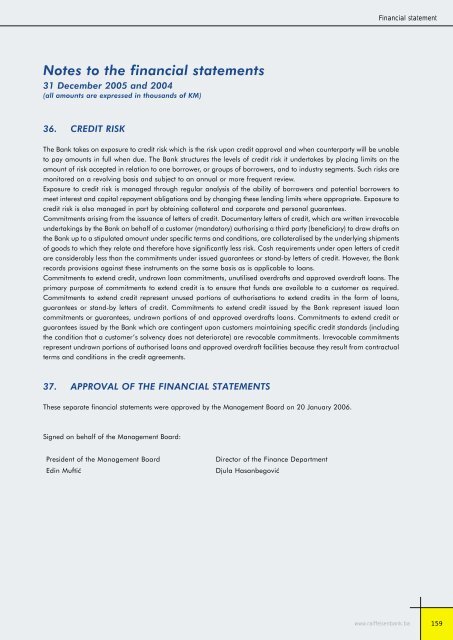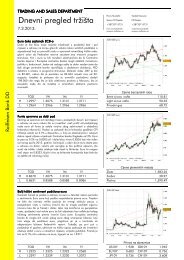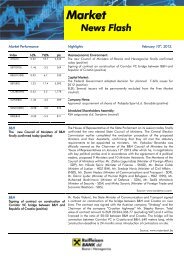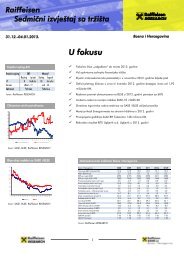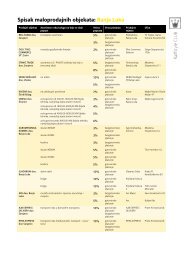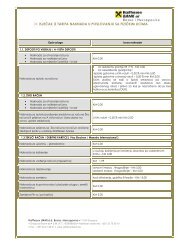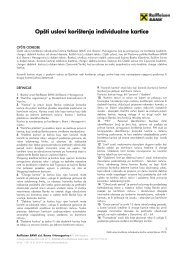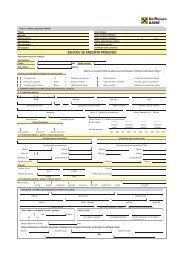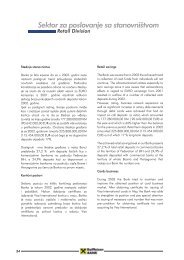Bilansi uspjeha - Raiffeisen Bank
Bilansi uspjeha - Raiffeisen Bank
Bilansi uspjeha - Raiffeisen Bank
Create successful ePaper yourself
Turn your PDF publications into a flip-book with our unique Google optimized e-Paper software.
Notes to the financial statements<br />
31 December 2005 and 2004<br />
(all amounts are expressed in thousands of KM)<br />
36. CREDIT RISK<br />
The <strong>Bank</strong> takes on exposure to credit risk which is the risk upon credit approval and when counterparty will be unable<br />
to pay amounts in full when due. The <strong>Bank</strong> structures the levels of credit risk it undertakes by placing limits on the<br />
amount of risk accepted in relation to one borrower, or groups of borrowers, and to industry segments. Such risks are<br />
monitored on a revolving basis and subject to an annual or more frequent review.<br />
Exposure to credit risk is managed through regular analysis of the ability of borrowers and potential borrowers to<br />
meet interest and capital repayment obligations and by changing these lending limits where appropriate. Exposure to<br />
credit risk is also managed in part by obtaining collateral and corporate and personal guarantees.<br />
Commitments arising from the issuance of letters of credit. Documentary letters of credit, which are written irrevocable<br />
undertakings by the <strong>Bank</strong> on behalf of a customer (mandatory) authorising a third party (beneficiary) to draw drafts on<br />
the <strong>Bank</strong> up to a stipulated amount under specific terms and conditions, are collateralised by the underlying shipments<br />
of goods to which they relate and therefore have significantly less risk. Cash requirements under open letters of credit<br />
are considerably less than the commitments under issued guarantees or stand-by letters of credit. However, the <strong>Bank</strong><br />
records provisions against these instruments on the same basis as is applicable to loans.<br />
Commitments to extend credit, undrawn loan commitments, unutilised overdrafts and approved overdraft loans. The<br />
primary purpose of commitments to extend credit is to ensure that funds are available to a customer as required.<br />
Commitments to extend credit represent unused portions of authorisations to extend credits in the form of loans,<br />
guarantees or stand-by letters of credit. Commitments to extend credit issued by the <strong>Bank</strong> represent issued loan<br />
commitments or guarantees, undrawn portions of and approved overdrafts loans. Commitments to extend credit or<br />
guarantees issued by the <strong>Bank</strong> which are contingent upon customers maintaining specific credit standards (including<br />
the condition that a customer’s solvency does not deteriorate) are revocable commitments. Irrevocable commitments<br />
represent undrawn portions of authorised loans and approved overdraft facilities because they result from contractual<br />
terms and conditions in the credit agreements.<br />
37. APPROVAL OF THE FINANCIAL STATEMENTS<br />
These separate financial statements were approved by the Management Board on 20 January 2006.<br />
Signed on behalf of the Management Board:<br />
President of the Management Board Director of the Finance Department<br />
Edin Muftić Djula Hasanbegović<br />
Financial statement<br />
www.raiffeisenbank.ba<br />
159


